In the Premier League midweek fixture, Wolves played against West Ham at the Molineux Stadium. Last weekend, the home team secured a 1-1 draw on Sheffield United, recorded a 9-game unbeaten role, that was the longest unbeaten streak of the team in history. Wolves participated in continental competition this season, played more matches, but they managed to obtain a balance between both competitions. They qualified to the knockout stages while occupied the 5th position in the domestic league.
Despite the 1-0 victory at the Stamford Bridge, West Ham played poorly recently, that was the only win in the last eight games. Manuel Pellegrini was under pressure, he must produce some positives results in the short term.
In this tactical analysis, we will show you the analysis of both teams, and how Nuno Espírito Santo’s tactics won the game.
Lineups
Wolves lined up in a 5-4-1 formation, which they seldom used in last season. Romain Saïss was suspended last game, he returned to the squad and Max Kilman was on the bench. The Belgian Leander Dendoncker continued to play as a right centre back, ahead of proper centre back Jesús Vallejo. The rest of the team remained the same from last game, which Jonny Otto, Rúben Neves, João Moutinho, and Matt Doherty at the midfield.
For West Ham, they played in a 4-4-1-1 formation. Same with their opponent, Pellegrini only made one change in his lineup. Michail Antonio was injured, the most expensive West Ham player in history, Sébastian Haller backed to the lineup. Felipe Anderson was behind the lone striker, with Pablo Fornals and Robert Snodgrass on both sides.
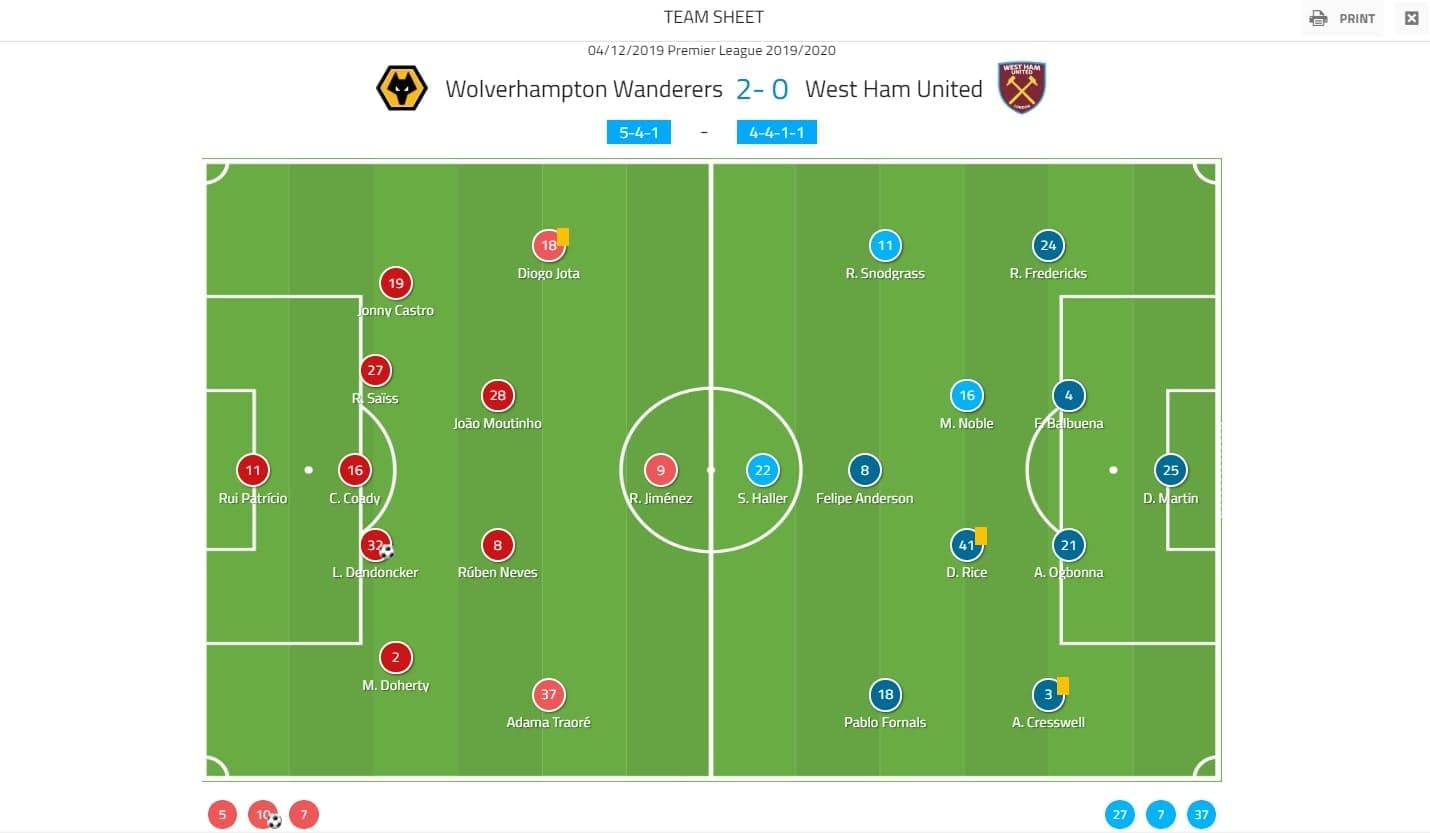
Poor defending of the away team
In order to illustrate the weak defence of West Ham, first, we showed how easy could Wolves kept the ball under their feet. Nuno’s team style was not playing from the back, but the West Ham defence, again, lacked intensity, allowed Wolves to keep the ball.
West Ham defended in a 4-4-2 shape in this game. When Wolves got the ball, their centre backs, Dendoncker, Saïss and Conor Coady split wide to stretch West Ham players, with Doherty and Jonny provided the width on both sides. Meanwhile, Neves occupied the centre of the pitch, and on occasions, Moutinho dropped to receive the ball.
They could carry out this approach easily, as there were flaws in West Ham defence. The players were not cooperating with each other off the ball, they lacked an organized press or a solid compact block. For example, in the below scene, Haller pressed Saïss, but this hardly succeeds as he was the only player to press. In this phase, Wolves enjoyed a numerical superiority. Saïss returned the ball to Coady.
And, when Coady received the ball, Anderson tried to close off Neves. But, this did not stop Wolves from moving the ball, as Dendoncker and Doherty were on the right side of the pitch, providing themselves as solutions to get over Anderson and Haller. Where were the rest West Ham players? The pass per defensive action (PPDA) of West Ham was 20.56 in the first half, that was too easy for Wolves to pass.
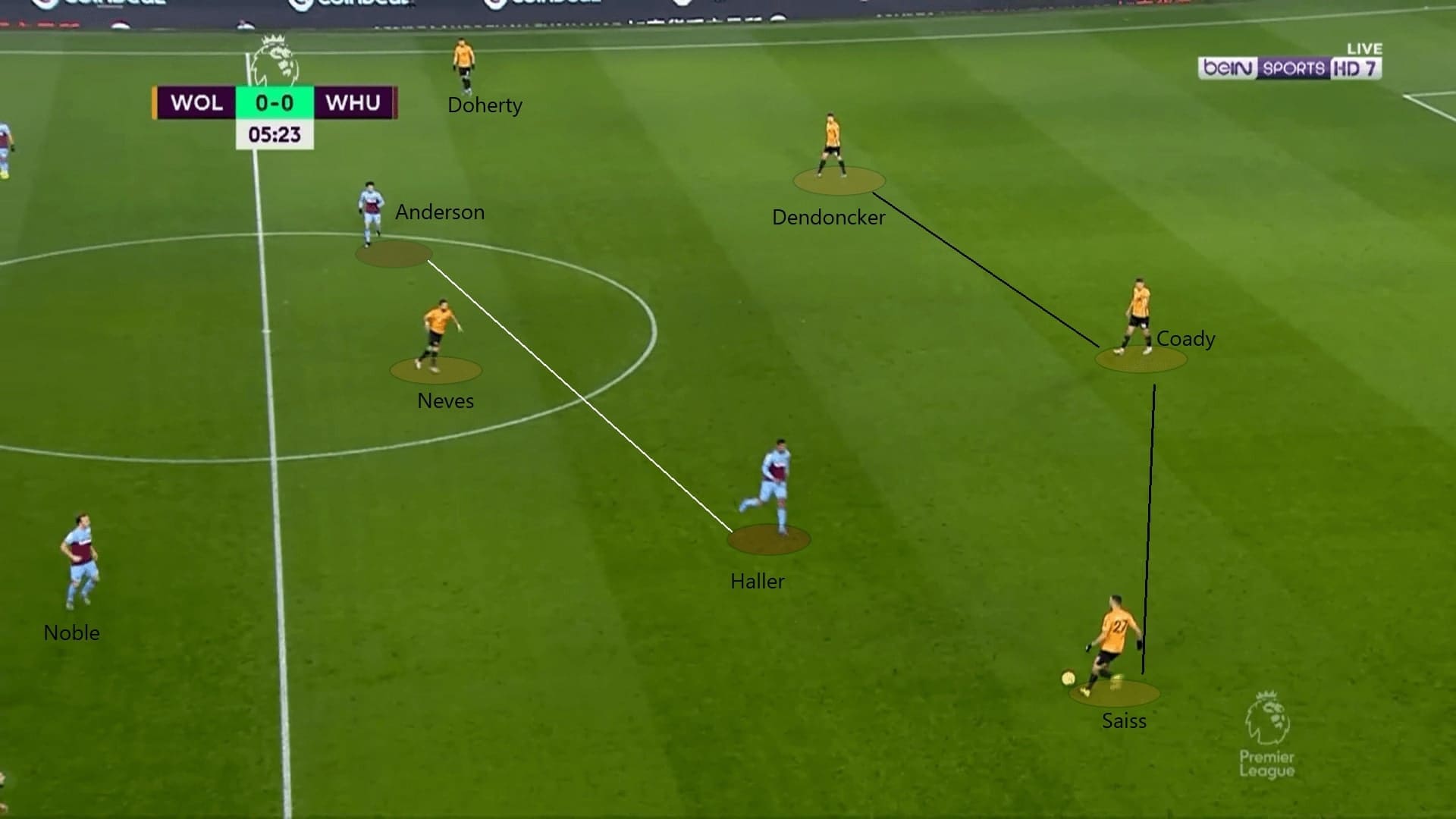
The poor defence, not only unorganized but lacked intensity, as well as poor marking. Maybe, this could be attributed to the unclear instructions on assigning defensive duties of West Ham players, part of it was on Pellegrini, but players on the pitch should do better.
This example revealed the above issues. In the first phase, the light pressure of Haller did not prevent Saïss from passing the ball vertically to Raúl Jiménez. Mark Noble was overloaded by the dropping move of the Mexican and Moutinho. Meanwhile, Snodgrass was aware of Jonny on the left flank. Under this circumstance, Noble decided to gamble, he predicted the ball would then play to Moutinho, he tried to move a step towards the Portuguese. Jiménez anticipated this, and turned wisely to space behind Noble, entered the final third easily and created a chance for Wolves.
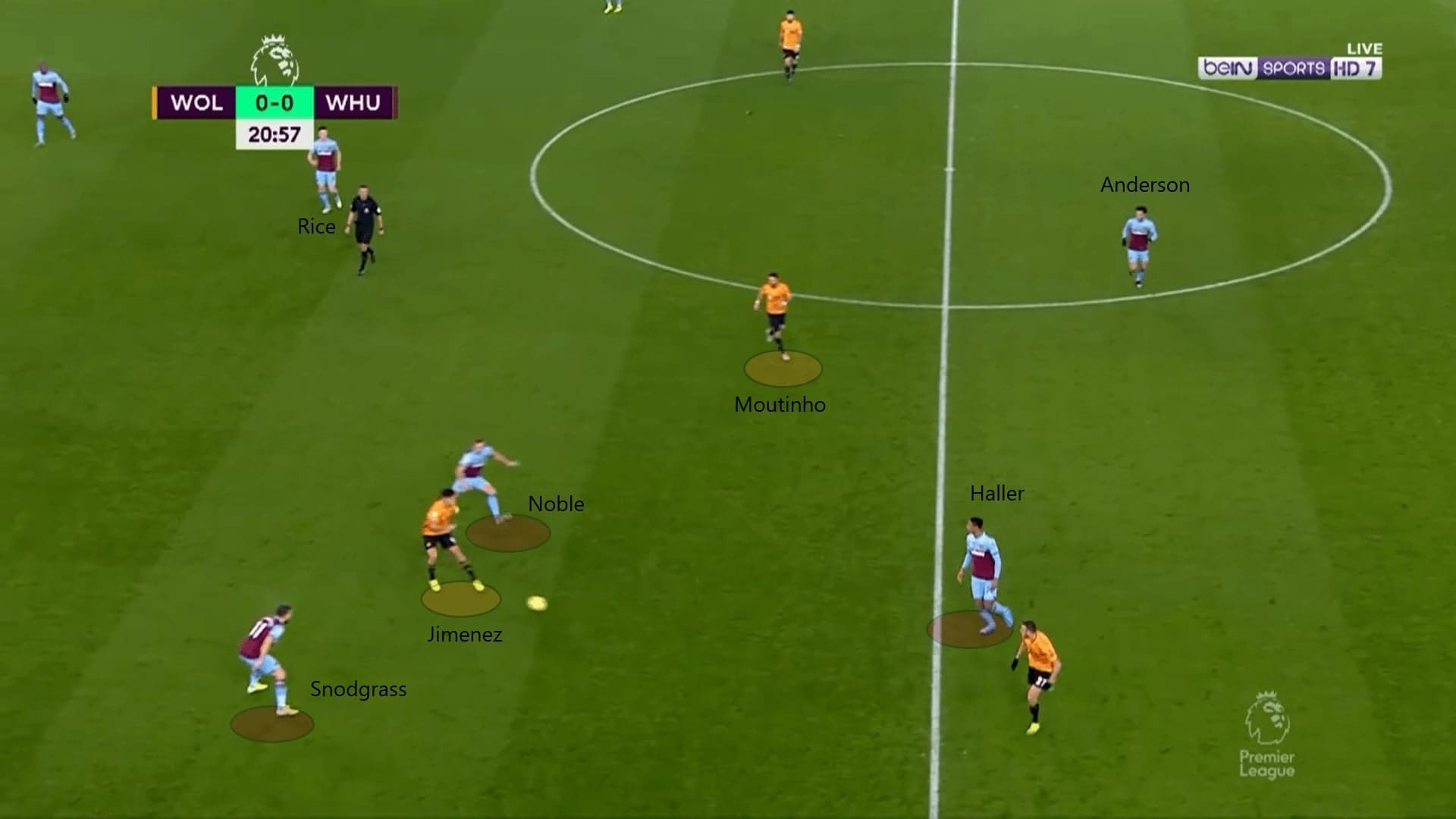
There were questions of the West Ham defence. Were there principles of defence? If the key of tactics was to deny central penetrations, then Snodgrass would move to press Jiménez together. It was very possible to force the ball wide. If the key concept of Pellegrini’s defence was tight marking, then what Anderson was too far away from Moutinho, while Haller did not provide enough pressure on Saïss; Noble was too late on Jiménez.
The unclear defensive approach of Pellegrini had lasted for matches this season, this was an issue had to be solved, as quick as possible.
The Traoré -Doherty partnership
Given to the poor defence of West Ham, Wolves got plenty of chances to attack, their xG of this game was 2.24. Apart from Jiménez and Diogo Jota, another highlight of Wolves’ attack was the partnership between Doherty and Adama Traoré. The Spanish started 12 games in this campaign, already more than last season.
We believe the concepts of the movements on these two players were rather simple. One of the flank to provide the width, while the other one inverted to the half-spaces. There were two examples to illustrate.
In this scene, we could see the Wolves backline without pressure again, he tried a diagonal pass. Doherty made a forward run at the centre, caught the attentions from Fornals and Aaron Cresswell. Both West Ham left players expected a pass to Doherty. However, the recipient was Traoré. Wolves progressed the ball easily.
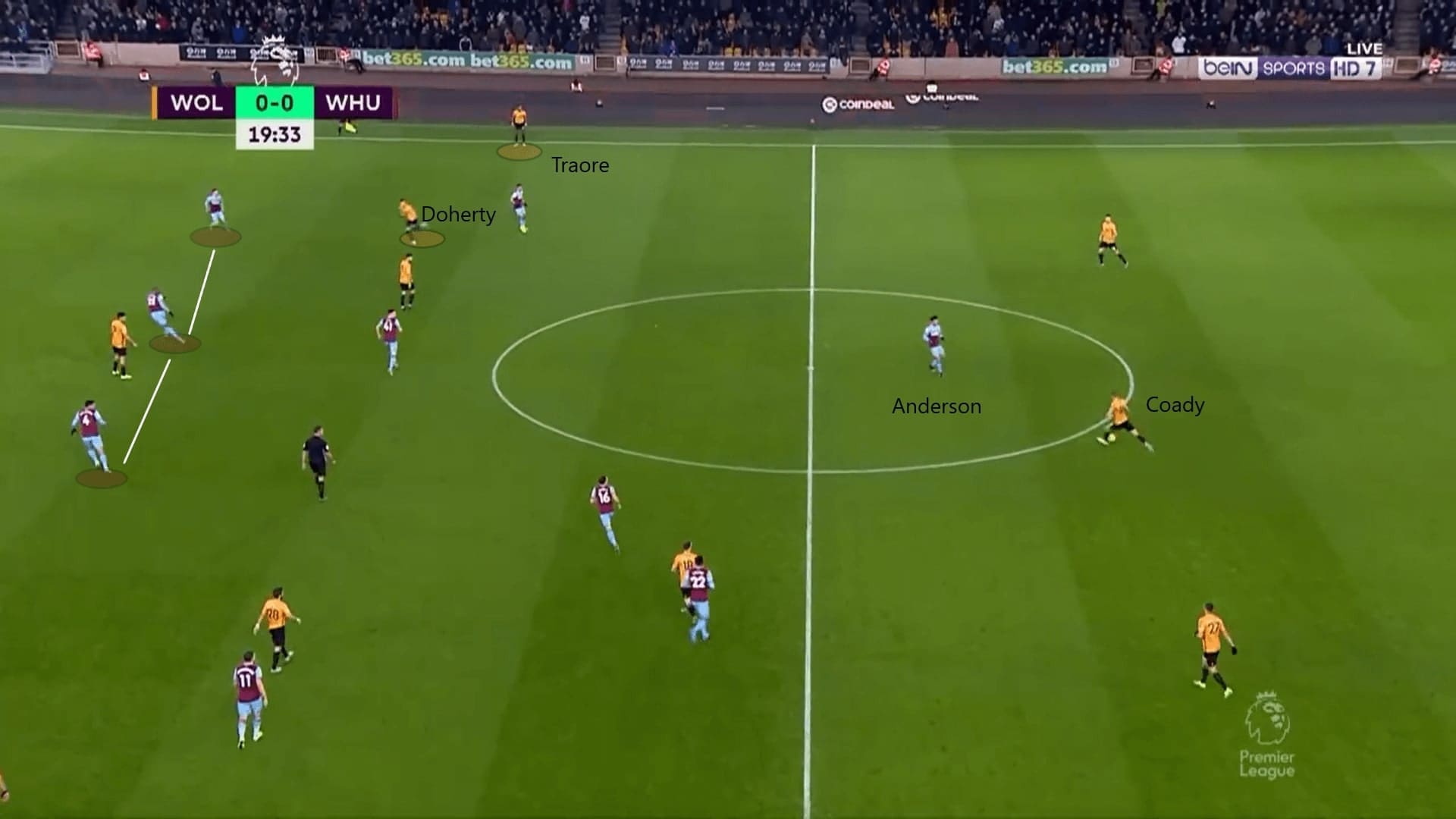
In the final third, the concept was the same, but the players were allowed to rotate their positions. Therefore, in this case, Traoré positioned himself at the half-spaces, and as a short option for Neves. This dragged Fornals further forward and far from Cresswell. The gap between Fornals and Cresswell, allowed Neves’ pass to pick out Doherty on the flank. A crossing was generated by the moves of the Traoré-Doherty partnership.
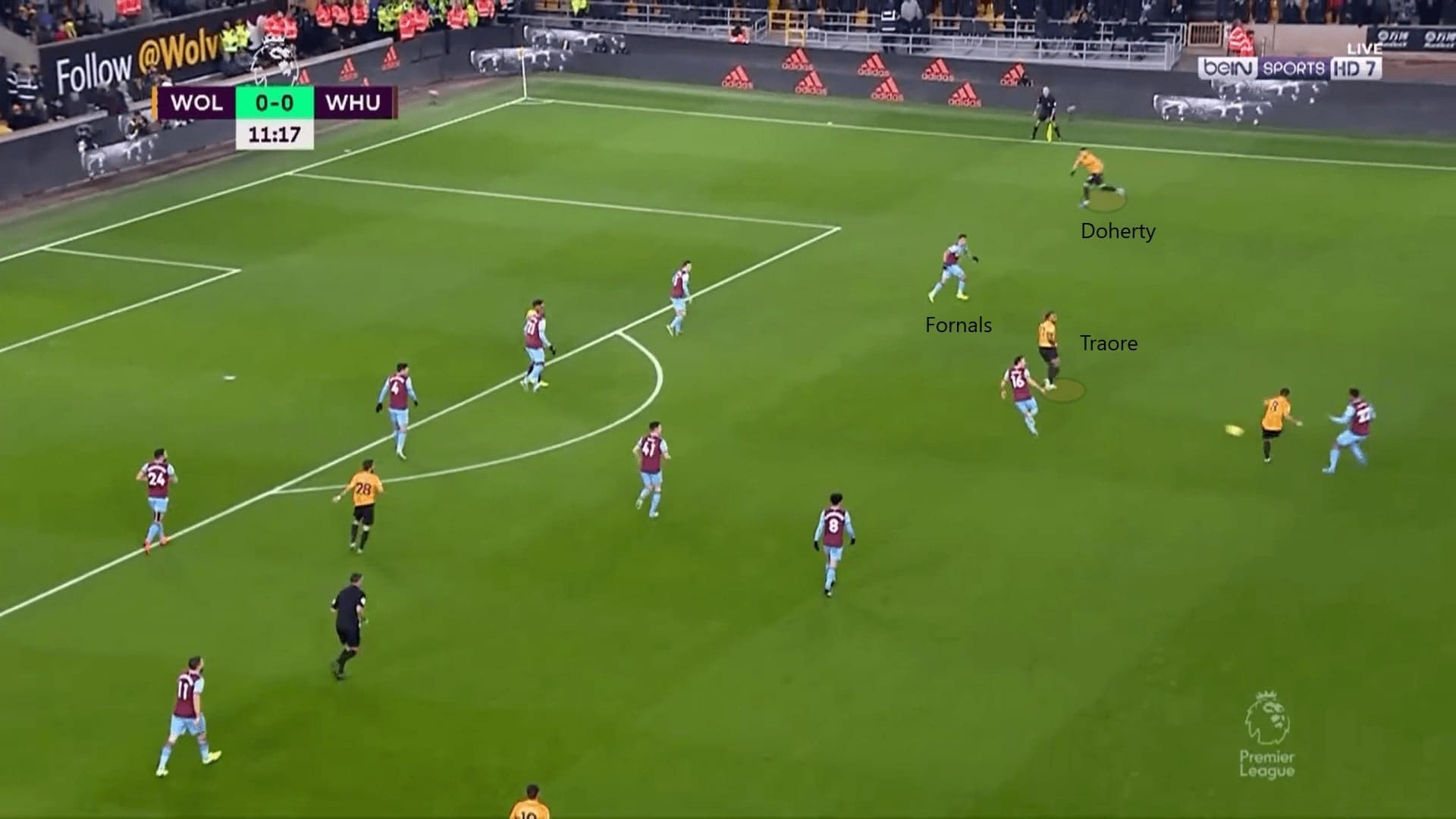
The midblock of Wolves
In contrast, the defence of Wolves were a lot better than West Ham, the away team only got an xG of 0.38 after 90 minutes. Wolves defended in a midblock, with a 5-4-1 shape, Traoré and Jota dropped to the midfield.
The block was compact, and Wolves committed numbers to lock the ball side, as the below situation reflected. West Ham positioned five players on the left side of the pitch, in order to prevent from an overload, Wolves also adjusted the position of their defence and moved to the ball side. The block contained West Ham players, cramped the space, it was vertically and horizontally compact to deny any penetrations. Even the short option at the midfield. Declan Rice was marked.
Therefore, Noble did not risk. The English could not progress the ball, and he played the ball back to Angelo Ogbonna.
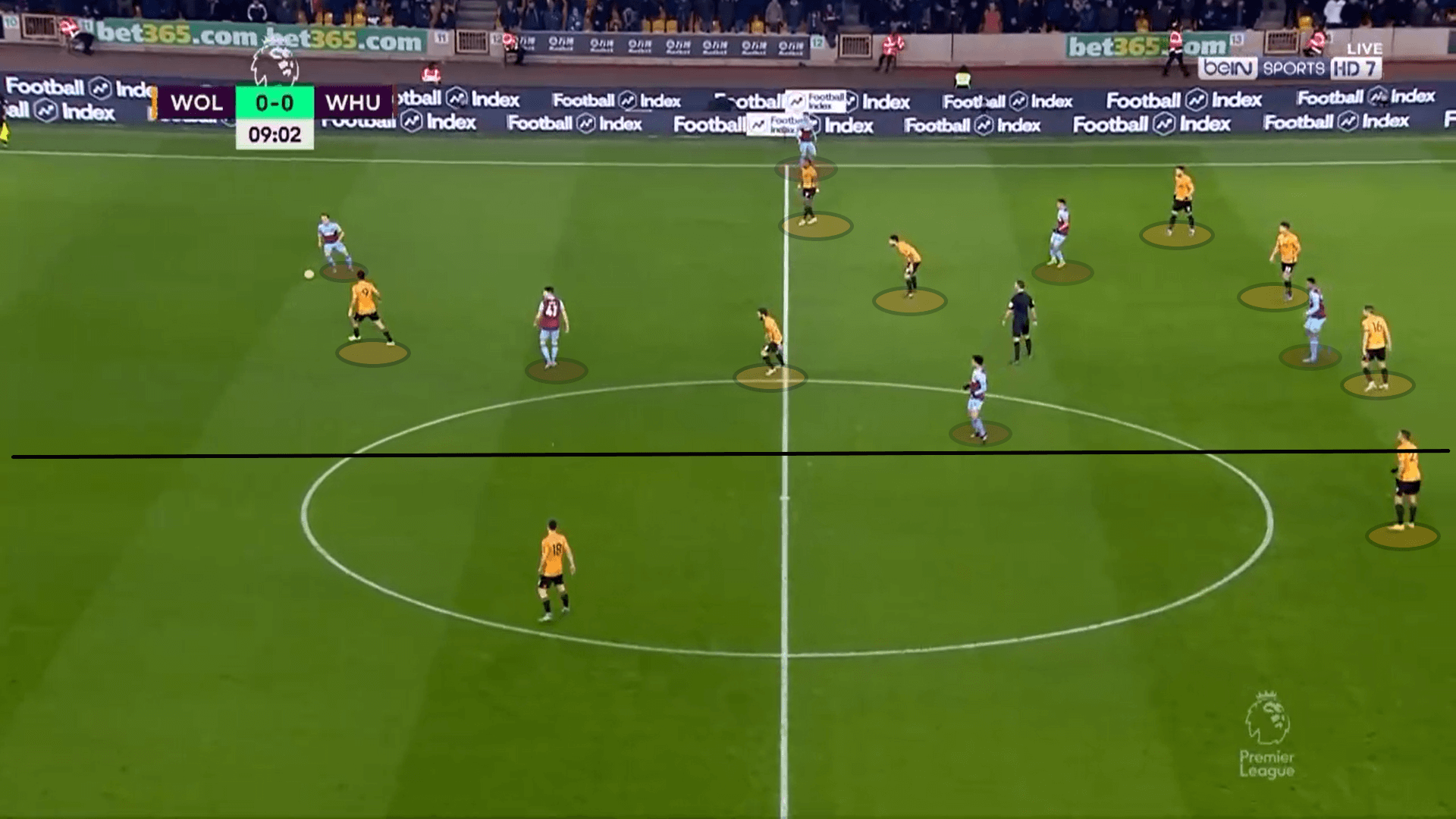
Inefficacy of the West Ham attack
Apart from the compact Wolves block that constrained the attack of West Ham, another huge reason resulted in a low xG was their poor attacking setups, including the below one. The xG of Pellegrini’s team was even poorer in the half time, with only 0.12.
In hopes of allowing Fornals and Anderson to roam their positions, Cresswell provided the width on the left side of the pitch, the West Ham attacking remained opened. However, they did not capitalize on this approach. The build-up of West Ham failed because of the poor movements of West Ham players. They did not drop or move to spaces to provide themselves as options for passes. For example, the Wolves midfielders covered West Ham players, and none of them even tried to receive a pass from Fabián Balbuena. The centre backs of West Ham often played long in this game. This time, Cresswell receive the ball.
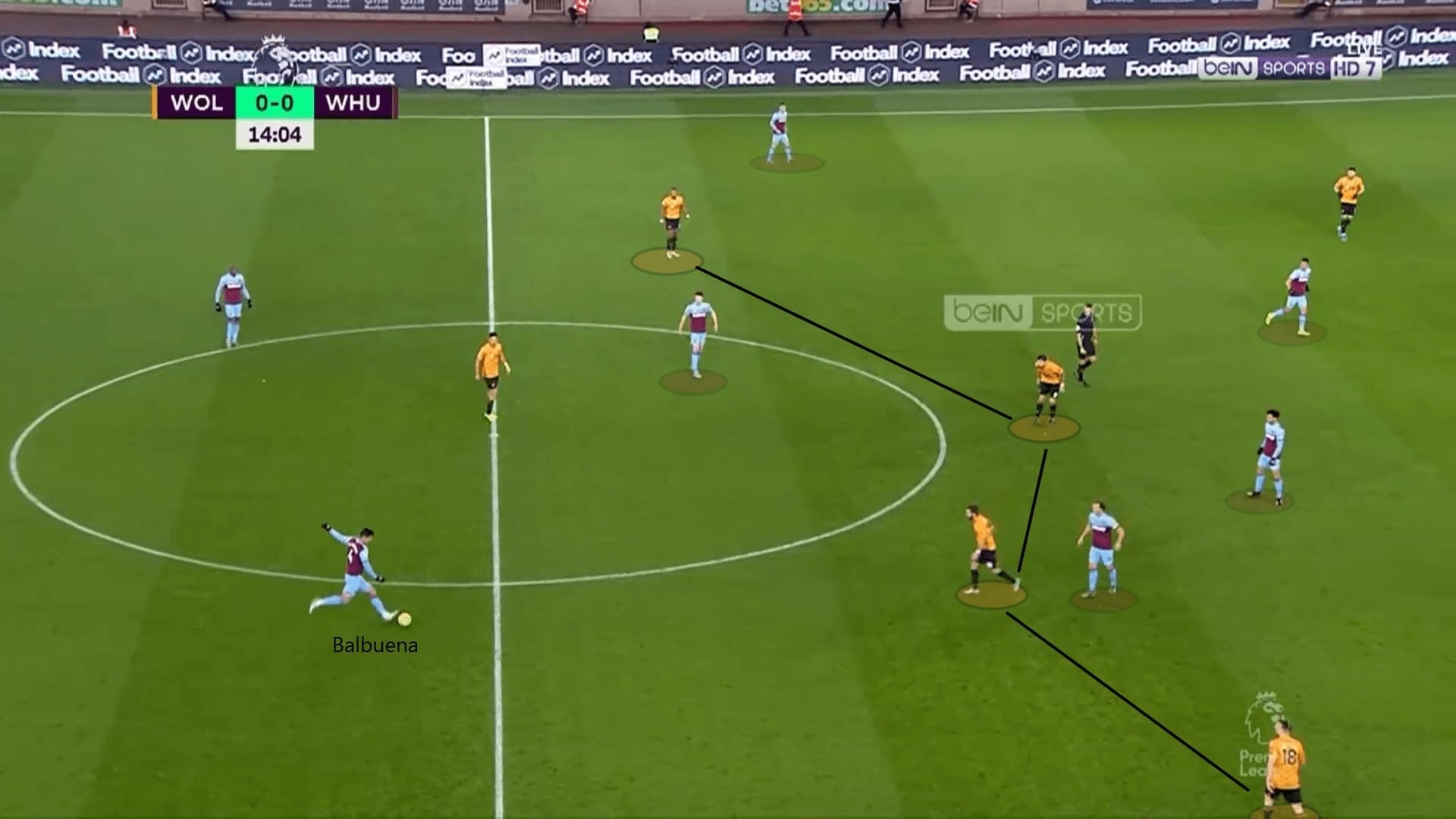
However, the approach of West Ham was ineffective. In order to reduce distances between players, the defensive line of Wolves was higher than usual. They played offside trap to prevent West Ham from exploiting space behind the defenders. Also, they forced West Ham played long by chasing the return passes.
In this scene, which Noble returned the ball to Balbuena, the Paraguayan was pressed by Moutinho. Meanwhile, since the 33-year-old Portuguese was out of position, spaces generated behind him. Disappointingly, no West Ham players were going to exploit those space, while another centre back, Ogbonna was marked by Jiménez. West Ham failed to play out from the back.
Seemed the West Ham front players were expecting a long pass, but Wolves played the offside trap. Fornals was caught offside here.
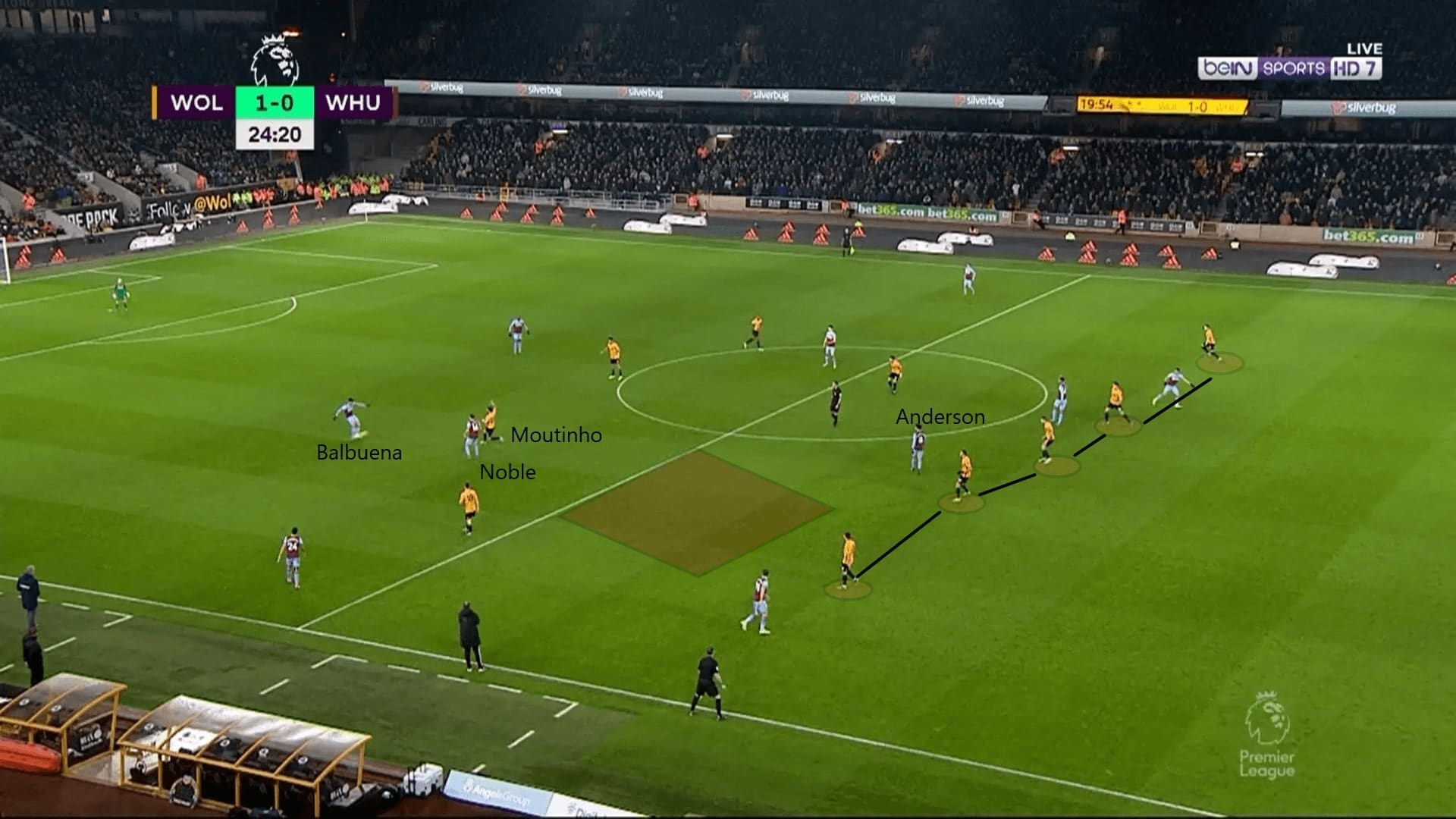
After Dendoncker scored from a corner, Wolves defended slightly deeper. This allowed West Ham had more rooms in the build-up, and finally they had shooting chances. However, they did not capitalize on the weakness of the Wolves defence. The distance between Dendoncker and Coady was an issue when defending, as after the Belgian stepped out to press, the skipper did not adjust his positions.
On this occasion, which West Ham entered the final third after several quick moves on the flank, they could not create a shooting chance. It was because their plays lacked creativity. Haller did not run between Dendoncker and Coady or behind the defenders; it was a three v three at Wolves backline, but West Ham did not try to play the ball to the centre of the pitch; instead, Rice was trapped at flanks, he did not have a good solution to progress.
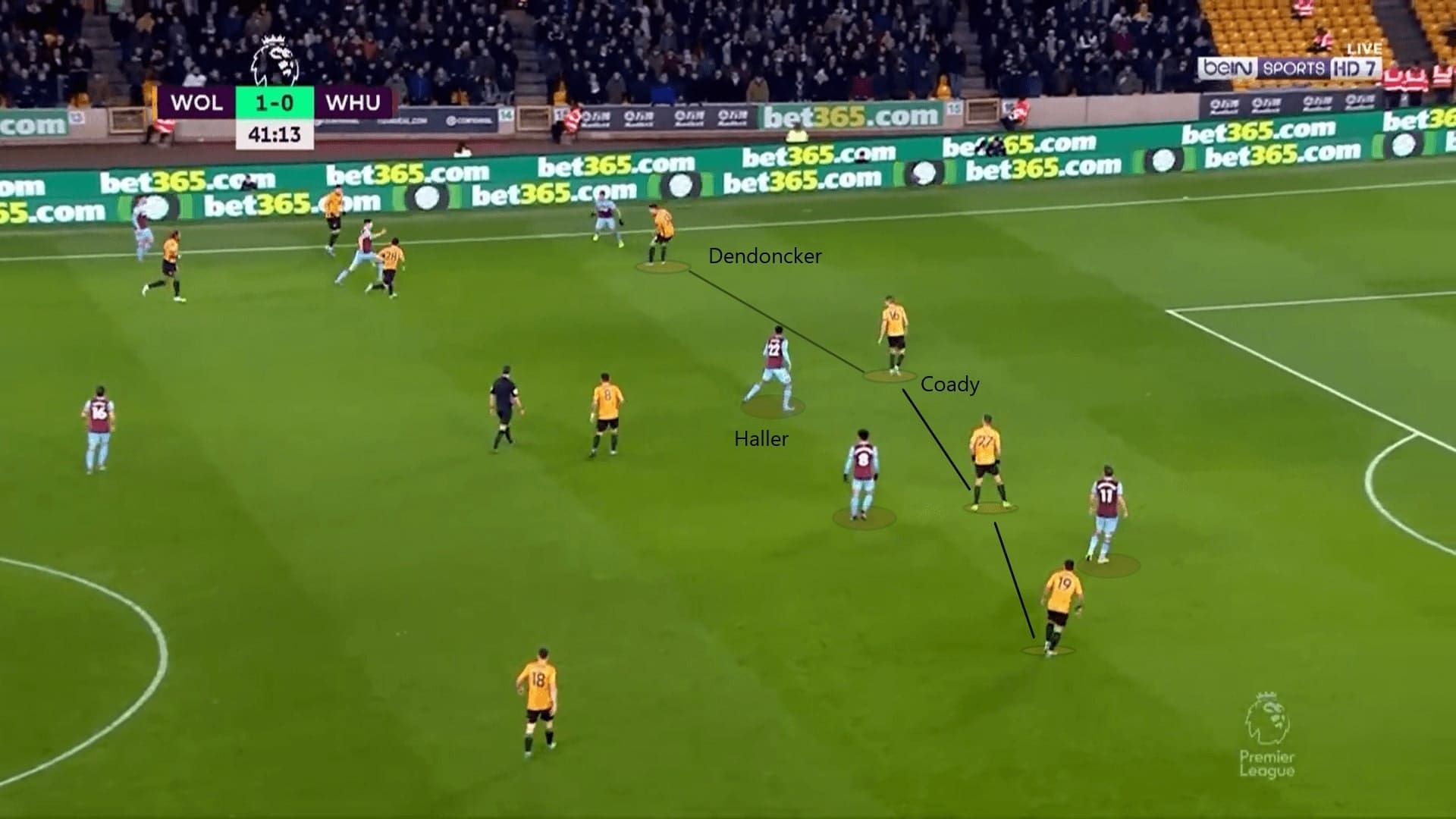
West Ham changes in the second half
The poor performance in the first half meant West Ham had to produce better performance in the second half. In the attack, Pellegrini made some changes, they tried to move the ball quicker, played with more patience and went long less, only 8.98% of those passes were long passes (in the first half, the figure was 12.71%). After Nathan Holland replaced Noble, Anderson dropped to the midfield, with his skills and techniques, West Ham were more confident to play at the centre of the pitch in the first phase. The Brazilian distributed the ball to flanks, the full-backs came forward to attack flanks. However, their crossing quality was not enough to find players in the box, their crossing accuracy was 14.29%, only two of their crosses succeed. Apart from crossings, hardly could they create their chances, they only managed to record six shots in the game.
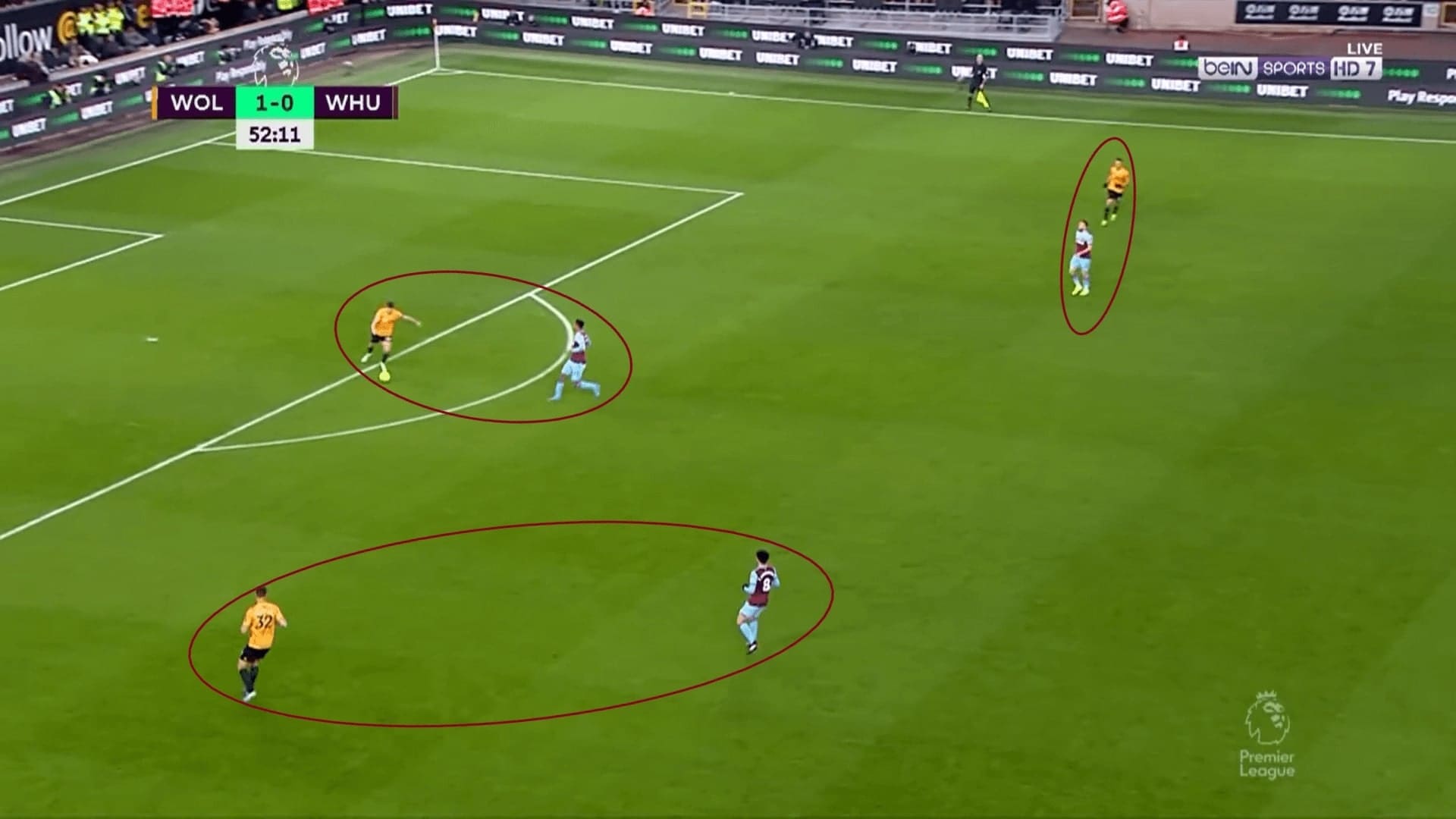
However, defensively, West Ham performed slightly better to prevent Wolves from playing at the back as easy as the first half. In contrast, their PPDA in the second half was 7.71. They pressed higher, included the above example, which they achieved numerical equality with Wolves. As shown, Dendoncker, Saïss and Coady split, but Anderson, Snodgrass and Haller closed off these three players. Wolves were under pressure, and the switch play of Coady went out of the pitch.
Wolves in transitions
After the break, Wolves’ greatest chances were from transitions. Since West Ham desperately needed a goal, they pushed forward. Therefore, Wolves managed to counter West Ham by exploiting spaces behind their defenders. Their players should be appreciated as they were alert to seize transitions to attack, as once Wolves won the ball at the midfield, players made forward runs.
Apart from the winning goal scored by Patrick Cutrone, Jiménez also got his chance as the following showed. The touch of Noble was slightly heavy, hence, he lost the ball. Moutinho did not wait for a second, he read the space between Ogbonna and Balbuena, quickly played a one-touch pass to find Jiménez on the counter. The Mexican did his job to sprint forward, resulted in a shooting chance. Meanwhile, Traoré was a pacey player, also created chances for his teams with his body strength and electric pace.
Statistically speaking, there were a total of seven counter-attacks from Wolves, four of them on target, and three of those four were from the second half.
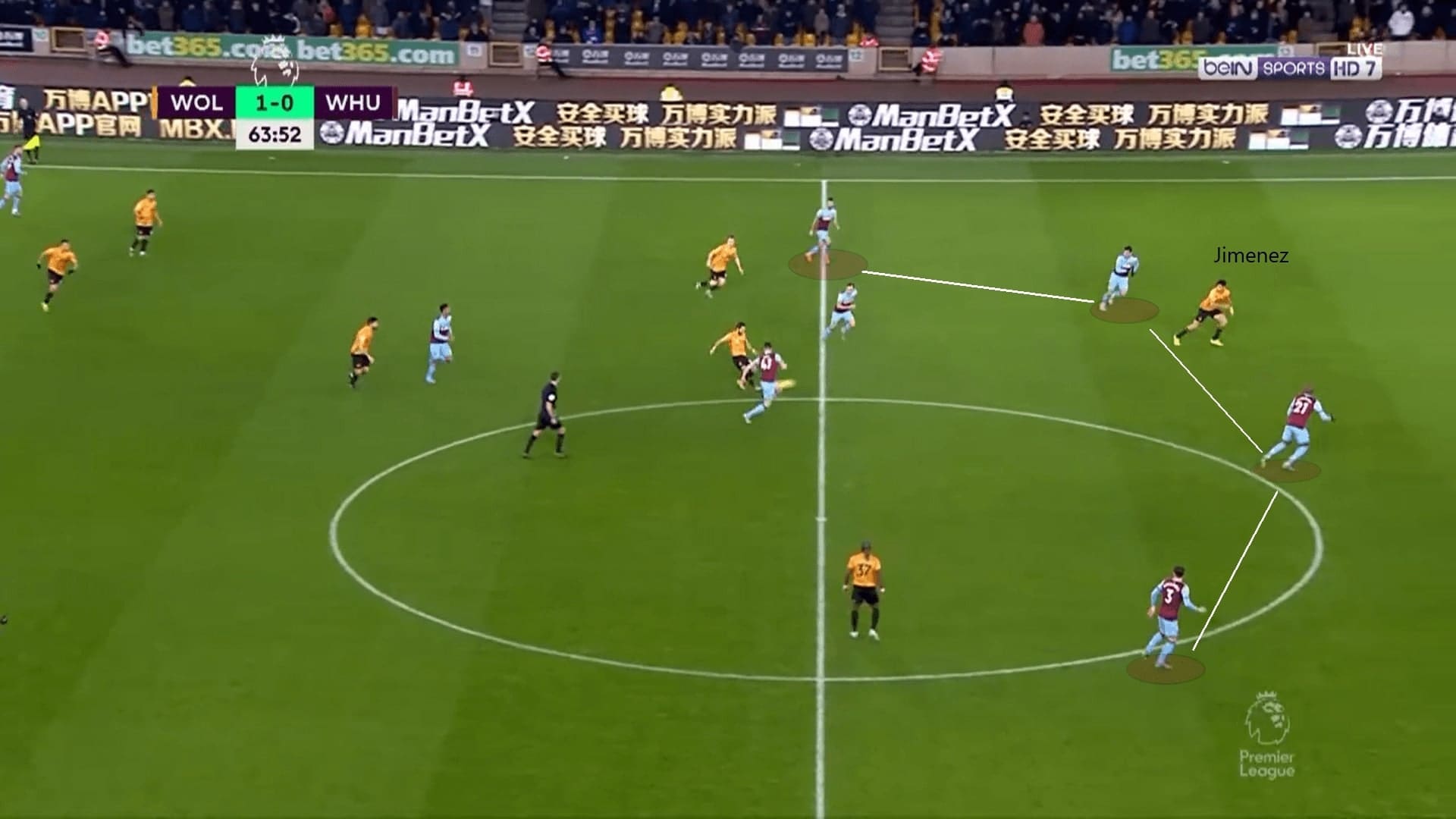
Conclusions
Wolves had a tight schedule in December, this was a very good win for them, which they continued to sit at the 5th of the table. The defence of Wolves remained the strongest part of the team, which hardly could the opponents broke it. Maybe, the spacing issue between Dendoncker and Coady was an issue to fix, but the return of Ryan Bennett from a groin injury could help. In the period of Willy Boly and Bennett were unavailable, Nuno flexibly adjusted the tactics and Traoré was the one who shined. The tactical flexibility of Nuno’s team could help the team to deal with more challenge in the future.
It was another disappointing night of West Ham again. Their players seemed lost motivation to play under Pellegrini, especially at the start of the game. Only after they conceded a goal, and after the break, they looked better. Not much time to leave for Pellegrini now, he must find a solution to solve his defensive issues, while finding ways to score goals.

If you love tactical analysis, then you’ll love the digital magazines from totalfootballanalysis.com – a guaranteed 100+ pages of pure tactical analysis covering topics from the Premier League, Serie A, La Liga, Bundesliga and many, many more. Buy your copy of the December issue for just ₤4.99 here





Comments